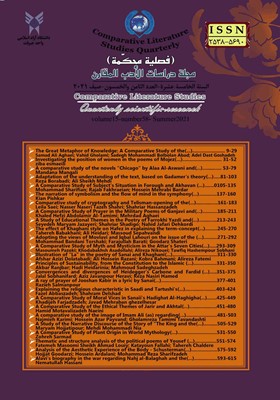-
-
List of Articles
-
Open Access Article
1 - The Great Metaphor of Knowledge: A Comparative Study of the Poems of Shirko Bikas and Abbas Yamini Sharif
Samad Ali Aghaei Vahid Gholami Sadegh Mohammadi Bolbolan Abad Adel Dast Goshadeh -
Open Access Article
2 - Investigating the position of women in the poems of Mojez Shabestari and Seyed Ashrafoddin Gilani
ziba esmaeili -
Open Access Article
3 - A comparative study of the novels "Chicago" by Alaa Al-Aswani and "Neighbors" by Ahmad Mahmoud
Mandana Mangali -
Open Access Article
4 - Adaptation of the understanding of the text, based on Gadamer's theory with Linda Hutchen's postmodernism theory*
Reza Borabadi Ali Sheikh Mehdi -
Open Access Article
5 - A Comparative Study of Subject's Situation in Forough and Akhavan Literature with Emphasis on Another Birth and Winter
Mohammad Sharifian Rajab Fakhraeian Hossein Mehrabi Bardar -
Open Access Article
6 - The narration of symbolism and the flow of mind in the symphony of the deads and towards the lighthouse
Kian Pishkar -
Open Access Article
7 - Comparative study of cryptography and Telisman-opening of the beginning of feasts in Shahnameh and Haft Peykar
Leila Saei Nasser Naseri Tazeh Shahri Shahriar Hassanzadeh -
Open Access Article
8 - A Comparative Study of Prayer in the Military Poems of Ganjavi and Jamil Sedghi Al-Zahawi
Khaled Hefzi Abdolamir Al-Tamimi Mehrdad Aghaei -
Open Access Article
9 - A Study of Educational Themes in the Poetry of Farrokhi Yazdi and Iraj Mirza
Seyedeh Maryam Jazayeri Shahriar Shadigo Nahid Jafari Dehkordi -
Open Access Article
10 - The effect of Khaghani style on Hafez in explaining the term-concept of Pir Moghan
Tahereh Babakhani Ali Heidari Massoud Sepahvandi -
Open Access Article
11 - A Comparative Study of Myth and Mysticism in the Attar's Seven Cities of Love with Bidel Dehlavi's Lyric Poems
Masoumeh Pazoki Khodabakhsh Asadollahi Alireza Nikouei Tawfiq Hashempour Sobhani -
Open Access Article
12 - Illustration of "La" in the poetry of Sanai and Khaghani
Afshar Azizi Dolatabadi Ali Hossein Razani Kobra Bahmani Alireza Fatemi -
Open Access Article
13 - Principles of Sustainability, from the Constitution to the Islamic Revolution, relying on the Poems of Farrokhi Yazdi and Behjati
Akbar Ranjbar Hadi Heidarinia Mahmoud Sadeghzadeh -
Open Access Article
14 - Convergences and divergences of Heidegger's Carbone and Fardid reading
Jalal Sobhanifard Aziz Javanpour Heravi Reza Nasiri Hamed -
Open Access Article
15 - Explaining the religious characteristic in Saadi and Tartushi's governmental thought; Case study of Golestan and Seraj Al-Moluk
Fazel Abbaszadeh Shahram Delshad -
Open Access Article
16 - A Comparative Study of Moral Vices in Sanaii's Hadighat Al-Haghigha and Saadi's Bustan
Khadijeh Farjadzadeh Javad Mehraban ghezelhesar -
Open Access Article
17 - A Study of the Narrative Discourse of the Story of "The King and the Maid" in Movlavi's Masnavi Based on Propp's Morphological Theory
Maryam Hojjatipour Mehdi Mohammadi Nia -
Open Access Article
18 - A Comparative Study of Plant Origin in World Mythology
Zohreh Sarmad -
Open Access Article
19 - Adopting the views of Movlavi and Iqbal Lahouri on the issue of the stages of realization of a perfect human being
mohamad bandani Farajullah Barati Goodarz Shateri -
Open Access Article
20 - Thematic and structure analysis of the political poems of Yousef Al-Khatib and Malek Al-Shoaraye Bahar
Fatemeh Masoomi Sheikh Ahmad Louiy Katayoun Fallahi Tahereh Chaldere -
Open Access Article
21 - A ray of prayer of Jooshan Kabir in a lyric by Sanai
Razieh Salmanpour -
Open Access Article
22 - A Comparative Study of the Ethical Themes of Jarir and Akhtal Contradictions
Hamid Motavalizadeh Naeini -
Open Access Article
23 - A comparative study of the image of Imam Ali (as) regarding generosity with an approach to several literary works
Najmieh Karimi Hossein Azar Payvand Gholamreza Tamimi Tavandashti -
Open Access Article
24 - Analysis of the Aesthetic Experience of the Body - Schusterman Foundation regarding Spinoza and Leibniz
Hojjat Goodarzi Hossein Ardalani Mohammad Reza Sharifzadeh -
Open Access Article
25 - Alavi's biography in the war regarding Nahj al-Balaghah and the poem of Abd al-Masih al-Antaki
Nematullah Hassani
-
The rights to this website are owned by the Raimag Press Management System.
Copyright © 2021-2025







